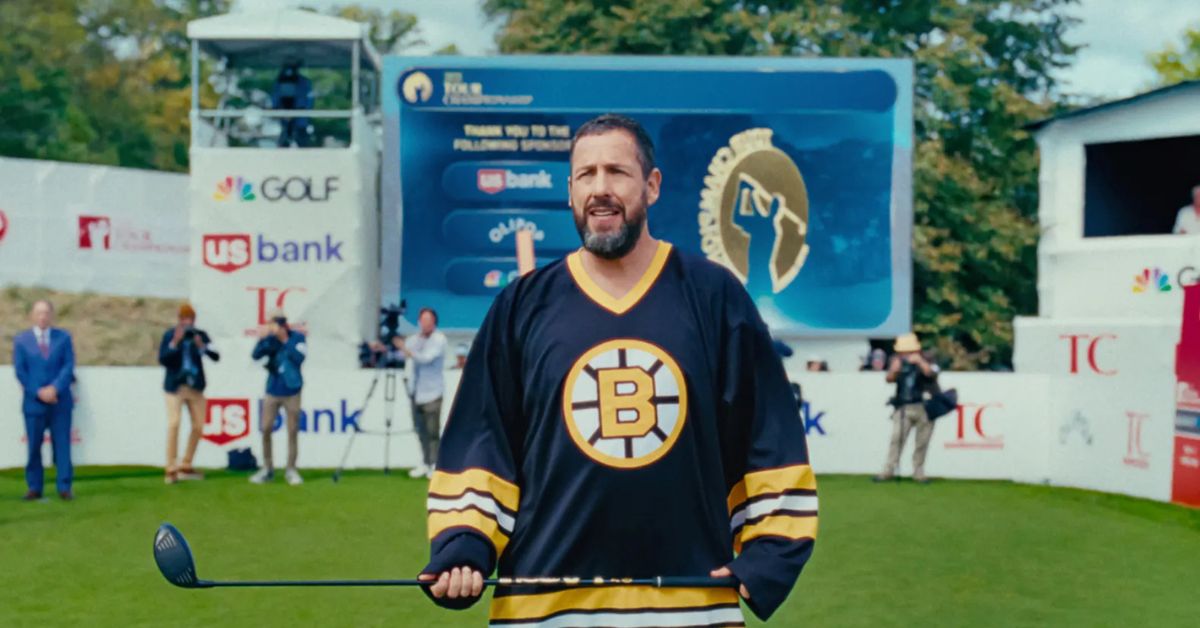
Happy Gilmore 2 – released on Netflix on July 25, 2025 reunites fans with Adam Sandler’s hot-headed golfer Happy Gilmore, nearly 30 years after the 1996 cult classic. Directed by Kyle Newacheck and co-written by Sandler and Tim Herlihy, the sequel sees Happy, now a retired family man, return to golf to fund his daughter Vienna’s ballet school tuition after a personal tragedy. With returning stars Julie Bowen, Christopher McDonald, and Ben Stiller, plus new faces like Benny Safdie and Bad Bunny, the film leans heavily on nostalgia but struggles to recapture the original’s charm. Mixed reviews highlight its slapstick energy and cameos but criticize its unfocused plot and overreliance on callbacks.
Story has Strong Start and Shaky Finish
The film’s opening act shines, reintroducing Happy as a broken man working at Stop & Shop, grappling with loss and alcoholism. Sandler slips back into the role effortlessly, blending his signature rage with poignant gravitas, as noted by Consequence for its “solid enough setup for a legacy sequel.” His four sons, played by Ethan Cutkosky, Maxwell Jacob Friedman, Conor Sherry, and Philip Fine Schneider, inherit his hockey-player temper, delivering early laughs with their brawling antics. The family dynamic, with Sunny Sandler as Vienna, echoes the original’s heartwarming drive to save Grandma’s house. However, a shocking plot twist—Virginia’s (Julie Bowen) early exit—feels like a cheap narrative crutch, akin to sequel tropes in Ted 2 or The Karate Kid II.
The second and third acts falter as the story splits between Happy’s redemption and a chaotic Maxi Golf League subplot, a flashy LIV Golf-inspired rival led by Safdie’s eccentric Frank Manatee. The league’s seven-hole, shot-clock format aims for satire but feels disjointed, with Screen Rant calling the narrative “scatterbrained” and unable to balance traditionalism versus innovation. The film clocks in at 1 hour 54 minutes, nearly 30 minutes longer than the original, bloated by excessive cameos and recycled clips. Variety praises the “raucously well-executed fan service” but admits some jokes don’t land, needing another draft.
Cameos Galore, But at a Cost
The sequel is packed with cameos, from golfers like Rory McIlroy, Scottie Scheffler, and John Daly to celebrities like Travis Kelce, Post Malone, and Stephen A. Smith. Bad Bunny steals scenes, and Christopher McDonald’s unhinged Shooter McGavin earns applause for his fallen-on-hard-times arc. Yet, the sheer volume of appearances—Nick Swardson, Rob Schneider, Paige Spiranac, and more—feels gratuitous. The Hollywood Reporter calls it “lazy and self-indulgent,” with non-actors like podcasters and influencers disrupting the flow. X posts echo this, with one user lamenting “too many athletes and celebrities ruining lines” while praising Daly and McGavin as bright spots. Another user gave it a 4/10, slamming the “worst script ever written” and “bad acting.”
The film pays tribute to deceased original cast members—Bob Barker, Carl Weathers, Frances Bay, Richard Kiel, and Joe Flaherty—via a graveyard scene, adding a bittersweet touch. However, constant flashbacks to the 1996 film, as noted by The Hollywood Reporter, make it feel like a “30-year high-school reunion” rather than a fresh story, alienating new viewers.
Hits and Misses in Comedy and Heart
Sandler’s comedic delivery remains a highlight, with Boston.com noting he’s “still undeniably funny” despite a “flabbier, shabbier” sequel. The training montage set to Foreigner’s Juke Box Hero and Happy’s brawls evoke the original’s slapstick charm. Yet, gags like a late tournament spectacle with “MTV x XFL” vibes feel forced, and Slash Film calls it an “absolute slog” lacking heart. The family subplot, while touching, is overshadowed by the chaotic Maxi Golf narrative, diluting emotional impact. X fans are split, with one calling it “genuinely funny with a lot of heart” but “a few strokes behind” the original. Another labeled it “pathetic” with “empty cameos” and “unfunny jokes.”
A Nostalgic but Flawed Effort
Happy Gilmore 2 earns mixed praise, with Rotten Tomatoes noting its “freshness” in family dynamics but criticizing its reliance on nostalgia. Roger Ebert gives it a passable score for its “sheer stupid energy” and slapstick appeal but admits it’s more fun to make than watch. The film’s 3/4 rating from Boston.com reflects its appeal to diehard fans, but Screen Rant argues it “fails where it counts” due to an unfocused plot. At 1 hour 54 minutes, trimming could have tightened its pace. Stream it on Netflix to judge for yourself, but temper expectations—it’s a nostalgic swing that doesn’t quite hit the hole-in-one.
